Narcissus and Kin
Flowers Are Small or Large, with Many Color Combinations

Plants in the genus Narcissus are lovely to look at and wonderful additions to the garden. The genus contains all the small-flowering species known commonly as narcissus, as well as the larger, showier daffodils. In fact, there is no clear division between the types. There are, however, 12 recognized divisions of daffodils as classified by the Royal Horticultural Society of England, the official International Registration Authority for the genus. Most of these are “of garden origin,” meaning that they are hybrids or cultivars selected for specific attributes.
There are certainly plenty of combinations of flower shape and color to be played with in this genus. The flowers have a unique shape with six petal-like parts surrounding a tubular or cup-shaped corona. These parts can be smaller or larger in relative proportion, flaring and short or narrow and deep, and of the same color or a combination of white, yellow, orange, or even red. The flowers can occur singly or in clusters (actually umbels) of two to 20. Most are also quite fragrant, an added bonus.
The groups are as follows: Trumpet daffodils, such as the well-known ‘King Alfred’, have a cup (the trumpet) as long as or longer than the surrounding petals and have one flower per stem. Large-cupped daffodils have a shorter cup that is still more than one-third the length of the petals, one flower per stem. Small-cupped daffodils have an even shorter cup — one-third or less the length of the petals, still one flower per stem. Double daffodils have their cup divided into many segments making a frilly bunch in the center, one flower per stem. Triandrus hybrids have cups at least two-thirds the length of the petals, several flowers per stem. Cyclamineus hybrids have petals that are reflexed back toward the stem (looking like cyclamen except for the cup in the center), one flower per stem. Jonquilla hybrids have two to four small, very fragrant flowers per stem and narrow, rush-like leaves instead of the usual flat ones. Tazetta hybrids are the ones usually referred to as narcissus and have short cups, several small flowers per stem, and intense fragrance. Poeticus daffodils have white petals, a very short, broad cup in a contrasting color, usually with a red edge, giving them the name pheasant’s eye. And lastly there are some species and their natural hybrids and forms, many quite miniature that are lumped together for convenience.
Amazingly, given their origins in many different countries and climates and the great diversity of flower types and sizes, all daffodils are quite easy to grow and adapt to most any care they are given. They prefer a dry summer spell but will do fine if they get watered anyway, survive freezing temperatures, and, though they continue to multiply year after year, don’t really need to be dug and divided if you don’t want to. Maybe best of all, they are unpalatable to burrowing gophers and grazing rabbits and deer. What they do like is full sun and well-drained soil. They can be successfully grown in pots, too, as the many nursery offerings demonstrate.
Enjoy the show this year, and think about planting more next fall to increase the display.



